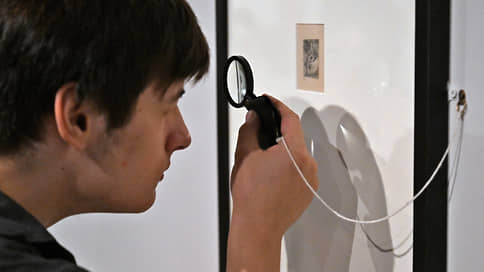Alchemy arose in half – Newspaper Kommersant No. 182 (7383) of 01.10.2022
[ad_1]

The Gallery of European and American Art of the Pushkin Museum has opened the exhibition “Alchemist’s Cauldron. Tactile gaze and non-visual perception. Part I”. On a very colorful artistic material – from engravings by old masters and objects of Buddhist worship to Picasso and modern Japanese ceramics – the viewer is invited to reconfigure his sight, touch and other senses. The task is not an easy one, Igor Grebelnikov.
The exhibition balances between serious and playful, between theory and practice: here it is proposed not only to look, but also to touch, listen, sniff and even fall into a trance. It is possible that many of its exhibits would have lain in the storerooms of the Pushkin Museum or would have remained in the permanent exhibition if it were not for the inclusive programs intensively developed by the Pushkin Museum.
The Alchemist’s Cauldron proceeds from the fact that our sense organs are imperfect in their own way, that art in different epochs took into account such “flaws”, and at the beginning of the 20th century, already directly, in the words of avant-garde artist Mikhail Matyushin, called for learning to “see everything at the same time, that is, even everything behind your back … learn to see with the back of your head, crown, temples and even footprints, just like Hindu yogis teach to breathe not only with the lungs, but with all parts of the body. Under this mantra in the last hall of the exposition, the viewer is invited to lie down, close his eyes, relax his body.
From section to section, the exhibition offers to experience different physical states – all this is quite unusual for the walls of the Pushkin Museum. Starting with paintings on mythological scenes by Claude Lorrain, an exemplary landscape painter of the era of classicism: it turns out that the majestic coloring of these paintings was achieved with the help of devices invented by him – a palette of glasses and a black mirror. The first had to be combined in a different way and already through them to look at nature, painted in the necessary morning or evening tones, while the mirror arranged the picture. Thus, the landscapes of Lorrain turned out to be a kind of filter, teaching to see nature. And at the end of the 18th century, when the British, due to the Napoleonic wars, lost the opportunity to travel around Europe and domestic tourism began to develop, “Claude glasses” came into use: they were used during the so-called sketch tours, where the views of England were painted in “alien” tones . At the exhibition, the visitor can also look around with the help of such glasses.
Next is a dark hall with stained-glass windows by German and Swiss masters of the 16th-19th centuries: some of them are shown for the first time after restoration – what is it not possible to mentally transport yourself to Gothic cathedrals or even to private houses, which were decorated with cabinet stained-glass windows. However, another aspect of this art is important for the exhibition: the light passing through the stained glass images turned the imaginary into the visible, becoming “divine light”.
The theme of blindness sounds differently in European and Asian art. Plots about the blind, led by the blind, at the exhibition – in etchings from the Bible by Piscator and Gabriel Smith after a drawing by Tintoretto. Blindness here is an allegory of short-sightedness, stupidity. But in Japan, since the 14th century, there was a guild of “blind men”, where the blind were taught various skills – for example, musical ones, and such musicians even became historical characters depicted on the old woodcuts shown here.
In one of the halls, the viewer is invited not only to watch, but to train in other feelings and sensations. The Japanese ceramist Nishimura Yesei, who taught modeling to the blind for many years, created objects for the exhibition that need to be touched and, in one case, to feel warmth, in another, to distinguish sounds, in the third, aroma.
The exhibition was conceived for a long time, and if the museum’s ties with Europe had not been cut off because of the military special operation in Ukraine, it would have turned out differently – more significant in volume and, perhaps, more convenient for perception. Judging by the published catalog, the culmination of the Alchemist’s Cauldron was to be a light installation by the Icelandic-Danish artist Olafur Eliasson, where the viewer in the dark would examine the changing rounded light projections, as if falling under their influence, simultaneously training their own optics and other sensory skills. In the absence of this “dark room”, such a reconfiguration requires much more effort. The project, however, is presented as a two-part project, but the second part, featuring works by contemporary European artists, has been postponed indefinitely. So far, the Alchemist’s Cauldron, depending on how you look and perceive, is half full. Or half empty.
[ad_2]
Source link






